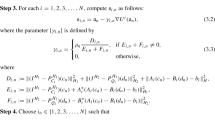Abstract
An inverse approach is developed to estimate the unknown heat conductivity and the convective heat transfer coefficient. The method relies on proper orthogonal decomposition (POD) in order to filter out the higher frequency error. The idea is to solve a sequence of direct problems within the body under consideration. The solution of each problem is sampled at a predefined set of points. Each sampled temperature field, known in POD parlance as a snapshot, is obtained for an assumed value of the retrieved parameters. POD analysis, as an efficient mean of detecting correlation between the snapshots, yields a small set of orthogonal vectors (POD basis), constituting an optimal set of approximation functions. The temperature field is then expressed as a linear combination of the POD vectors. In standard applications, the coefficients of this combination are assumed to be constant. In the proposed approach, the coefficients are allowed to be a nonlinear function of the retrieved parameters. The result is a trained POD base, which is then used in inverse analysis, resorting to a condition of minimization of the discrepancy between the measured temperatures and values calculated from the model. Several numerical examples show the robustness and numerical stability of the scheme.
Similar content being viewed by others
References
Atwell JA, King BB (2001) Proper orthogonal decomposition for reduced basis feedback controllers for parabolic equations. Mathematical and Computer Modelling 33:1–19
Aubry N, Lian WY, Titi ES (1993) Preserving symmetries in the proper orthogonal decomposition. SIAM J Sci Comput 14(2):483–505
Azeez MF, Vakakis AF (2001) Proper orthogonal decomposition (POD) of a class of vibroimpact oscillations. J Sound Vibrations 240(5):859–889
Ball KS, Sirovich L, Keefe LR (1991) Dynamical eigenfunction decomposition of turbulent channel flow. Int J Numer Meth Fluids 12:585–604
Beck JV, Blackwell B, St. Clair CR, (1985) Inverse heat conduction: Ill-posed problems. John Willey and Sons, New York
Berkooz G, Holmes P, Lumley JL (1993) The proper orthogonal decomposition in the analysis of turbulent flows. Annu Rev Fluids Mech 25(N5):539–575
Białecki RA, Kassab AJ, Ostrowski Z (2003) Application of the proper orthogonal decomposition in steady state inverse problems, In: Inverse problems in engineering mechanics IV. Masa. Tanaka (ed) Elsevier BV Amsterdam-Boston, pp. 3–12
Goldberg DE (1989) Genetic Algorithms in Search, Optimization, and Machine Learning. Addison-Wesley Reading, MA
Hardy RL (1971) Multiquadric equations of topolography and other irregular surfaces. J Geophys Res 76:1905–1915
Hardy RL (1990) Theory and applications of the multiquadric-biharmonic method: 20 years of discovery 1968–1988. Comput Math Appl 19(8–9):163–208
Holems P, Lumley JL, Berkooz G (1996) Turbulence, coherent structures, dynamical systems and symmetry. Cambridge Monographs on Mechanics, Cambridge University Press
Hotelling H (1983) Analysis of complex of statistical variables into principal components. J Educ Psychol 24:417–441
Karhunen K (1946) Ueber lineare Methoden der Wahrscheinigkeitsrechnung. Ann Acad Sci Fennicae A1 Math Phys 37:3–79
Liang YC, Lee HP, Lim SP, Lin WZ, Lee KH, Wu CG (2002) Proper orthogonal decompositopn and its applications – Part I: Theory. J Sound and Vibration 252(3):527–544
Loeve MM (1955) Probability theory. Van Nostrand, Princeton NY
Ly HV, Tran HT (2001) Modeling and control of physical processes using proper orthogonal decomposition. Math Comput Model 33:223–236
Özisik MN, Orlande HRB (2000) Inverse heat transfer: Fundamentals and applications. Taylor & Francis, New York
Pearson K (1901) On lines planes of closes fit to system of points in space. Lond Edinb Dublin Philos Magazine J Sci 2:559–572
Press WH, Teukolsky SA, Vetterling WT, Flannery BP (1992) Numerical recipies in FORTRAN: the art of scientific computing. Cambridge University Press, Cambridge
Tikhonov AN, Arsenin VA (1994) Solution of ill-posed problems. John Willey and Sons, New York
Wu CG, Liang YC, Lin WZ, Lee HP, Lim SP (2003) A note on equivalence of proper orthogonal decomposition methods. J Sound Vibration 265:1103–1110
Author information
Authors and Affiliations
Corresponding author
Rights and permissions
About this article
Cite this article
Ostrowski, Z., Białecki, R.A. & Kassab, A.J. Estimation of constant thermal conductivity by use of Proper Orthogonal Decomposition. Comput Mech 37, 52–59 (2005). https://doi.org/10.1007/s00466-005-0697-y
Received:
Accepted:
Published:
Issue Date:
DOI: https://doi.org/10.1007/s00466-005-0697-y




